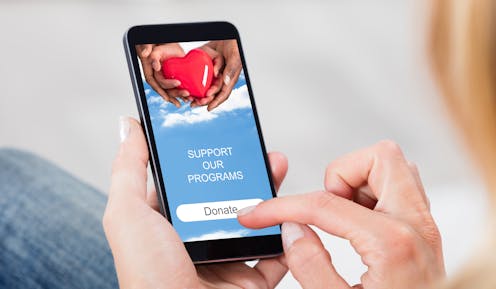Online fundraising may require different strategies for different devices − new research
Because smartphones can make people focus more on their personal needs, it can be harder to persuade their users to donate on them than it is when someone sees an appeal on their PC.

Most charities aren’t tailoring their online fundraising strategies to the electronic device donors may use when deciding whether to click a “donate” button. That’s what our marketing research team determined when we reviewed the donation pages of every nonprofit on the Forbes Top 100 Charities list.
Instead, people typically see identical appeals whether they’re using smartphones or personal computers. But in a series of studies we conducted regarding this issue, our team determined that this approach may undercut fundraising efforts.
Stefan J. Hock, Kelly B. Herd and I are marketing scholars who teamed up for this research project. We published our findings in the March 2024 issue of the Journal of Consumer Psychology.
In one study, we showed 247 people a real appeal for donations from the Salvation Army on either their smartphone or PC. People who completed the study on smartphones indicated feeling less focused on other people and were thus less likely to give money to the Salvation Army. We donated all designated funds to the Salvation Army after the study was complete.
We also controlled for whether participants had ever donated to a charity, how often they donate, how much they donate annually, how often they donate online, their gender, their age and their income.
In another experiment, we teamed up with a German charity, Aktion Deutschland Hilft – “Campaign Germany Helps,” in English. Using images from its website, we created Google ads that either focused on helping others or not. The former stated, “The people suffering in Ukraine need help.” The latter asserted, “We provide emergency help for Ukraine.”
We again found that smartphone users were less likely than PC users to click on the call for donations when it wasn’t focused on others. When the ad was focused on helping others, however, smartphone and PC users were equally likely to donate.
Our findings demonstrate that by explicitly highlighting the needs of others, charities can overcome what we call the “mobile giving gap” and help raise more money from smartphone users.
Why it matters
Persuading someone to make a charitable donation often requires getting them to feel empathy for others. But recent research has identified what’s known as a “mobile mindset”: People are more likely to think about their own needs, and less likely to think of others, when they’re looking at their smartphones.
Because smartphones often feel like an extension of ourselves, they can induce people to focus intently on their own needs and interests.
Online giving accounted for about 12% of the money that charities raised in 2023, according to Blackbaud, a software company many charities rely on for this purpose. The share of donors making at least some of their gifts online is rising and reached 40% in 2023, a consulting firm found.
Based on our findings, we suggest that charities aim to tailor their appeals according to the kind of device a donor is using. That’s easily accomplished through programs such as Google Ads, which lets advertisers target ads to people based on the device they’re using.

What still isn’t known
More research is needed to investigate whether the kind of device used may also influence the likelihood that someone may participate in other activities that benefit society.
For example, researchers could examine whether the device type makes a difference in a user’s willingness to volunteer in hospitals, at homeless shelters and other settings. Or they could explore how receiving messages on a smartphone or a PC can affect openness to recycling or buying environmentally friendly products.
It may also be worth exploring whether mobile website design features, such as the prominence or absence of “donate” buttons, can affect fundraising outcomes.
Kristen Ferguson does not work for, consult, own shares in or receive funding from any company or organization that would benefit from this article, and has disclosed no relevant affiliations beyond their academic appointment.
Read These Next
Epstein’s victims deserve more attention than his ‘client list’
Powerful men connected to Jeffrey Epstein are named, dissected and speculated about. The survivors,…
Christmas trees are more expensive than ever in Colorado — what gives?
Most Christmas trees are imported from other states, which drives up costs.
Getting peace right: Why justice needs to be baked into ceasefire agreements – including Ukraine’s
Just war theory, a centuries-old field of ethics, deals with how and when to start conflicts. It can…





